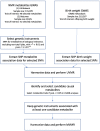Using Mendelian Randomisation to Prioritise Candidate Maternal Metabolic Traits Influencing Offspring Birthweight
- PMID: 35736469
- PMCID: PMC9231269
- DOI: 10.3390/metabo12060537
Using Mendelian Randomisation to Prioritise Candidate Maternal Metabolic Traits Influencing Offspring Birthweight
Abstract
Marked physiological changes in pregnancy are essential to support foetal growth; however, evidence on the role of specific maternal metabolic traits from human studies is limited. We integrated Mendelian randomisation (MR) and metabolomics data to probe the effect of 46 maternal metabolic traits on offspring birthweight (N = 210,267). We implemented univariable two-sample MR (UVMR) to identify candidate metabolic traits affecting offspring birthweight. We then applied two-sample multivariable MR (MVMR) to jointly estimate the potential direct causal effect for each candidate maternal metabolic trait. In the main analyses, UVMR indicated that higher maternal glucose was related to higher offspring birthweight (0.328 SD difference in mean birthweight per 1 SD difference in glucose (95% CI: 0.104, 0.414)), as were maternal glutamine (0.089 (95% CI: 0.033, 0.144)) and alanine (0.137 (95% CI: 0.036, 0.239)). In additional analyses, UVMR estimates were broadly consistent when selecting instruments from an independent data source, albeit imprecise for glutamine and alanine, and were attenuated for alanine when using other UVMR methods. MVMR results supported independent effects of these metabolites, with effect estimates consistent with those seen with the UVMR results. Among the remaining 43 metabolic traits, UVMR estimates indicated a null effect for most lipid-related traits and a high degree of uncertainty for other amino acids and ketone bodies. Our findings suggest that maternal gestational glucose and glutamine are causally related to offspring birthweight.
Keywords: Mendelian randomisation; amino acids; birthweight; genetics; glucose; lipids; maternal; metabolites; nuclear magnetic resonance; offspring.
Conflict of interest statement
D.A.L. receives support from several national and international government and charitable research funders, as well as from Medtronic Ltd. and Roche Diagnostics for research unrelated to that presented here. All other authors declare no conflict of interest.
Figures




References
-
- Blencowe H., Cousens S., Chou D., Oestergaard M., Say L., Moller A.-B., Kinney M., Lawn J., the Born Too Soon Preterm Birth Action Group Born too soon: The global epidemiology of 15 million preterm births. Reprod. Health. 2013;10((Suppl. S1)):S2. doi: 10.1186/1742-4755-10-S1-S2. - DOI - PMC - PubMed
Grants and funding
- MC_QA137853/MRC_/Medical Research Council/United Kingdom
- MR/N024397/1/MRC_/Medical Research Council/United Kingdom
- MC_UU_00011/1/MRC_/Medical Research Council/United Kingdom
- MC_PC_21038/MRC_/Medical Research Council/United Kingdom
- MC_UU_00011/1, MC_UU_00011/3, MC_UU_00011/6/MRC_/Medical Research Council/United Kingdom
- MC_UU_00011/6/MRC_/Medical Research Council/United Kingdom
- 101021566/ERC_/European Research Council/International
- CH/F/20/90003/BHF_/British Heart Foundation/United Kingdom
- WT_/Wellcome Trust/United Kingdom
- MC_UU_00011/3/MRC_/Medical Research Council/United Kingdom
- AA/18/7/34219/BHF_/British Heart Foundation/United Kingdom
- MC_PC_17228/MRC_/Medical Research Council/United Kingdom
- 218495/Z/19/Z/WT_/Wellcome Trust/United Kingdom
LinkOut - more resources
Full Text Sources

